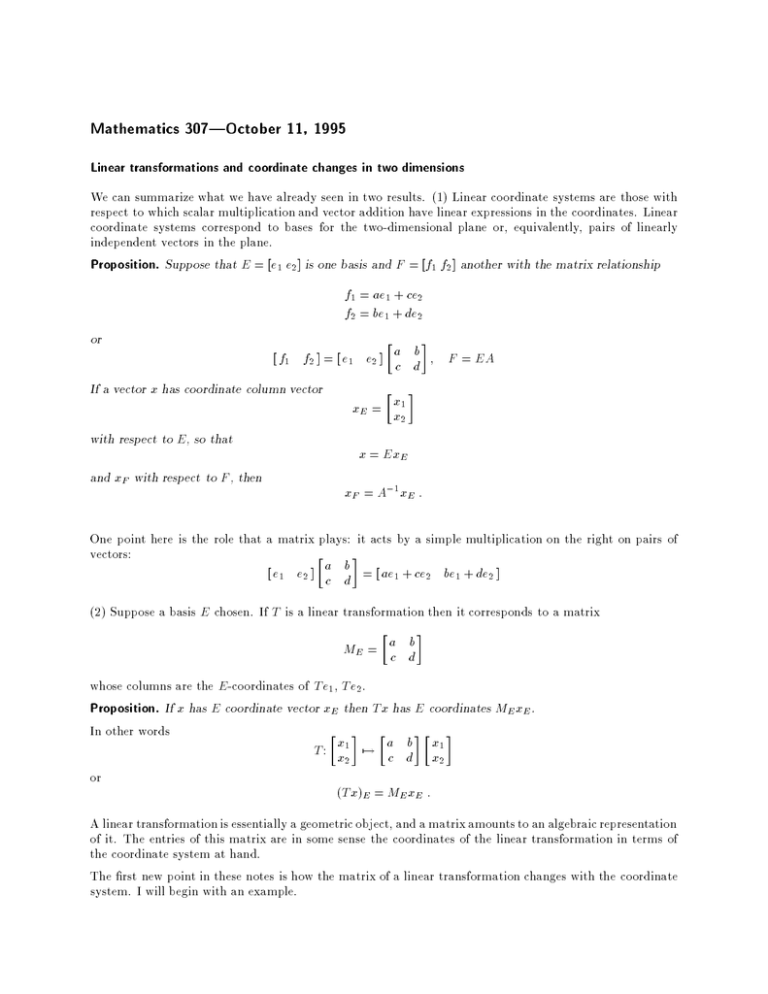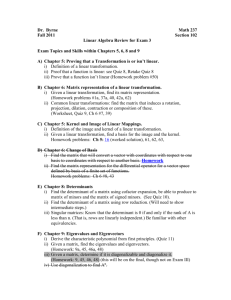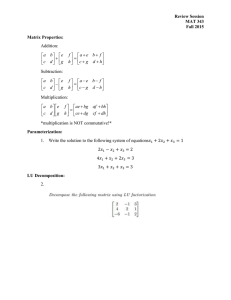Mathematics 307|October 11, 1995
advertisement

Mathematics 307|October 11, 1995 Linear transformations and coordinate changes in two dimensions We can summarize what we have already seen in two results. (1) Linear coordinate systems are those with respect to which scalar multiplication and vector addition have linear expressions in the coordinates. Linear coordinate systems correspond to bases for the two-dimensional plane or, equivalently, pairs of linearly independent vectors in the plane. Proposition. Suppose that E = [e1 e2 ] is one basis and F = [f1 f2 ] another with the matrix relationship f1 = ae1 + ce2 f2 = be1 + de2 or [ f1 f2 ] = [ e1 e2 ] ac db ; F = EA If a vector x has coordinate column vector xE = xx12 with respect to E , so that x = ExE and xF with respect to F , then xF = A,1 xE : One point here is the role that a matrix plays: it acts by a simple multiplication on the right on pairs of vectors: a b [ e1 e2 ] c d = [ ae1 + ce2 be1 + de2 ] (2) Suppose a basis E chosen. If T is a linear transformation then it corresponds to a matrix ME = ac db whose columns are the E -coordinates of Te1 , Te2 . Proposition. If x has E coordinate vector xE then Tx has E coordinates ME xE . In other words x a b 1 T : x2 7! c d xx12 or (Tx)E = ME xE : A linear transformation is essentially a geometric object, and a matrix amounts to an algebraic representation of it. The entries of this matrix are in some sense the coordinates of the linear transformation in terms of the coordinate system at hand. The rst new point in these notes is how the matrix of a linear transformation changes with the coordinate system. I will begin with an example. Linear transformations and coordinate changes in two dimensions Example. Suppose 2 f1 = e1 + e2 f2 = ,e1 + e2 Dene the linear transformation to be a scale change, but instead of one along the axes, it will scale by a factor of 2 along the line y = x and by a factor of 1=2 along the line y = ,x. These directions are the lines through f1 and f2 , so that Tf1 = 2f1 Tf2 = f2 =2 The matrix of the transformation T in the F -coordinate system has as its columns the coordinate vectors of Tf1 and Tf2 in the F -coordinate system. The F -coordinates of 2f1 are (2; 0) and those of f2 =2 are (0; 1=2), so the matrix of T in F -coordinates is 2 0 MF = 0 1=2 : What is the matrix of T in the E -coordinate system? We will use two methods to nd the answer. The rst is more complicated but more direct. The columns of the matrix are the vectors Te1 , Te2 expressed as linear combinations of e1 and e2 . So we must gure out what the eect of T is on e1 and e2 . Linear transformations and coordinate changes in two dimensions 3 Try e1 rst. The basic trick here is to resolve e1 into its components along the lines y = x and y = ,x. As you can see from the picture and verify, this resolution is e1 = (1=2)f1 , (1=2)f2 and since T is linear so the rst column of ME is Te1 = (1=2)Tf1 , (1=2)Tf2 = 2(1=2)f1 , (1=2)(1=2)f2 = f1 , (1=4)f2 = (e1 + e2 ) , (1=4)(,e1 + e2 ) = (5=4)e1 + (3=4)e2 5=4 3=4 For the second we must nd Te2 . The picture shows that e2 = (1=2)f1 + (1=2)f2 so that so that the second column is making the matrix ME equal to Te2 = (1=2)Tf1 + (1=2)Tf2 = 2(1=2)f1 + (1=2)(1=2)f2 = f1 + (1=4)f2 = (e1 + e2 ) + (1=4)(,e1 + e2 ) = (3=4)e1 + (5=4)e2 3=4 5=4 5=4 3=4 : 3=4 5=4 Linear transformations and coordinate changes in two dimensions 4 Its eect on a grid in the E coordinate system is this: Keep in mind: this is the same transformation as before, but its eect is portrayed on a dierent grid. In a second method: the meaning of the matrix ME is that (Tx)E = ME xE and similarly for F -coordinates (Tx)F = MF xF : Recall also that xF = A,1 xE ; xE = AxF : If we apply this to Tx instead of x we have (Tx)F = A,1 (Tx)E But then if we substitute for (Tx)E from the rst equation in this we get (Tx)F = A,1 ME xE = A,1 ME A xF and if we compare this we the second equation we see that MF = A,1ME A : This is the third main result of these notes. Proposition. Suppose E and F are are two bases with F = EA. If T is a linear transformation, ME is its matrix with respect to E and MF its matrix with respect to F then MF = A,1ME A : This calculation is essentially the same as the direct calculation we did rst, although it might not not seem to be. (It is somewhat dierent from what I did in class.) You have probably seen an equation like this in some earlier class, where it was said to express the fact that ME and MF are similar. This Proposition means that similar matrices are the matrices of the same linear transformation, but for dierent choices of coordinate systems. Linear transformations and coordinate changes in two dimensions 5 Eigenvectors and coordinate change If T is a linear transformation, an eigenvector of T is a vector (other than the zero vector) on which T acts by scaling. In other words, T takes it into a multiple of itself. The scale factor involved is called the eigenvalue of T associated to that eigenvector. In other words, v 6= (0; 0) is an eigenvector of T if and only if there exists a constant c such that Tv = cv : This is a geometric notion: it means that in the direction of v the transformation T acts by shrinking or stretching or whatever, but preserves the direction itself. In particular, this is a notion independent of any choice of coordinate system. But in order to nd the eigenvectors and eigenvalues, unless you are lucky, you should expect to work with a coordinate system and a matrix. I recall that if M is the matrix of T in some coordinate system then its eigenvalues are the roots of the polynomial equation det(M , cI ) = 0 where I is the identity matrix 1 0 : 0 1 This will be a quadratic equation. If c is an eigenvalue then the system of equations M xE = 0 will be singular, and will have a one-dimensional set of solutions. Any of these solutions other than (0; 0) will be an eigenvector. If c1 and c2 are two real eigenvalues with eigenvectors x1 , x2 and the eigenvectors are linearly independent (which will always be the case if c1 6= c2 ) then we can choose this pair as a basis aand the matrix of T in this coordiante system will be c1 0 : 0 c 2 This is, in a sense, the point of eigenvectors: the matrix of a linear transformation has a simple form if we choose a basis made up of eigenvectors. When the two-dimensional linear transformation has two linearly independent eigenvectors, it is said to be diagonalizable. Even it is diagonalizable, there may be some problems in using eigenvectors to visualize the linear transformation. Example. Let T be rotation through 90 . Its matrix in a suitable coordinate system is 0 ,1 : 1 0 It should be clear geometrically that there are no vectors in the plane that are scaled by T , since every vector other pthan the origin changes direction under the rotation. Nonetheless, T is diagonalizable: its eigenvalues are ,1, and its eigenvectors are complex. Not every linear transformation is diagonalizable, even if we allow complex eigenvalues. If T is a horizontal shear, then the only vectors whose direction does not change under T are those lying along the x-axis. In other words, for shears there exist real eigenvectors but there do not exist two linearly independent ones. The next main result in this course is that, roughly speaking, every linear transformation is either (1) diagonalizable in real directions; (2) the combination of a rotation and a uniform scale change; or (3) the combination of a shear with a uniform scale change. The classication depends on whether T has (1) real eigenvalues and two linearly dependent eigenvectors; (2) conjugate complex eigenvalues; (3) two equal eigenvalues and only one line of eigenvectors.









